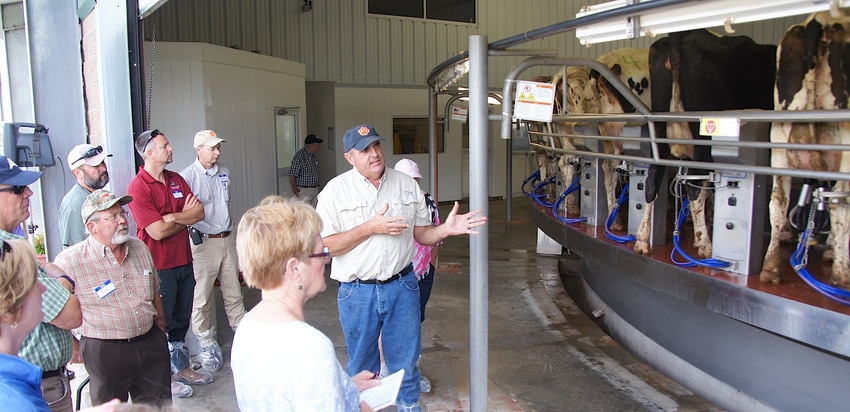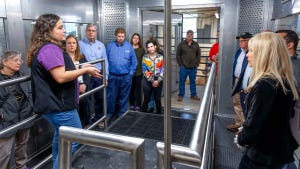Lines of separation secure potential sources of pathogens away from animals, farm workers or food products.
August 10, 2017

Cleanliness can save lives — untold numbers, in fact. On farms and food processing and handling facilities, cleanliness is more than just hand washing; it’s full-fledged biosecurity, and it’s changing the way farmers involved in animal agriculture work.
“Biosecurity procedures are fundamental to the prevention of disease and the safety of animals and food,” said Boyd Parr, South Carolina state veterinarian and director of Clemson University Livestock Poultry Health (LPH). “They’re designed to prevent the spread of disease onto an animal agriculture site, between animals on a site and from one site to another.”
The pathogens that cause disease are everywhere — in air or water, among animals and birds, on clothes and shoes, on hands and feet and even on cars and trucks. The tiniest virus, bacterium or fungus can hitch a ride onto a farm unnoticed until it causes an outbreak of disease.
Consider the challenge of minimizing all of these threats on, for example, a 3,500-acre dairy farm with 35 employees who milk nearly 1,500 cows three times a day. That’s the situation at the Satterwhite Farm in Newberry County, S.C., where Parr and other veterinarians addressed more than 150 people on the topic of biosecurity at an all-breeds summer field day sponsored, in part, by the South Carolina Jersey, Holstein and Guernsey associations.
The Satterwhite family has farmed this land since 1935 and is raising a fifth generation to take the reins in the future, including the farm's 60-stall rotary milking parlor that milks 360 cows per hour.
Every nine seconds, a cow enters the slowly spinning carousel as another completes its milking and steps off. It takes just three minutes to fully milk each cow as the platform revolves a full 360 degrees. Among the most important functions of the rotary milking parlor is the ease with which handlers can see to the cleanliness of the milking process as each cow enters a stall and is coupled to the milker.
Such extra steps toward biosecurity are a hallmark of the Mid-Atlantic Secure Milk Supply, a 12-state program stretching from South Carolina to Pennsylvania. The program is designed to create processes that will prepare dairy farmers, milk haulers and processors to take extra biosecurity steps that could allow them to continue to move milk safely in the advent of a foot and mouth disease (FMD) outbreak, thus helping them stay in business and also keeping milk available for consumers.
Though FMD is a highly contagious disease that infects cattle and other hooved animals, including pigs, sheep, goats and deer, it is not a public health or food safety concern. Nonetheless, the law doesn’t allow infected animals or their byproducts to enter the food chain. An FMD outbreak in the U.K. in 2001 caused a crisis in the agriculture industry. Farmers and agricultural officials are determined to prevent a similar situation from affecting American beef and dairy production.
To protect their farm, the Satterwhites have restructured their dairy’s operation using a biosecurity concept called “lines of separation.”
“Lines of separation literally secure potential sources of pathogens away from animals, farm workers or the dairy product,” Parr said. “You don’t want to bring anything on and you don’t want to take anything off without properly addressing potential biological threats.”
Actual lines are drawn — or spray-painted — to divide areas of traffic on the Satterwhite farm. Incoming people, animals, vehicles, equipment and supplies stay outside the production areas of the farm until they have gone through sanitation procedures. The idea is to break what veterinarians call the “chain of infection” in which disease-producing agents use a method of transportation to infect a host.
“The goal is to isolate the unit to keep any infectious disease from entering or leaving the premises,” said Julie Helm, Clemson LPH poultry specialist veterinarian. “Breaking any part of the chain of infection will reduce the risks to your herd or flock.”
People and their vehicles are a primary mode of transportation for disease-causing pathogens. For this reason, the Satterwhites installed a truck wash at the farm gate. No production vehicles enter the facility without a disinfectant spray.
Feet get the same kind of treatment. Employees and visitors alike stop at the line of separation to don disposable plastic boots. Before entering the milking parlor, everyone must walk through a disinfectant pan.
“Our feet are easy modes of transportation for pathogens, but they’re also easy to address,” said Charlotte Krugler, a Clemson LPH emergency preparedness veterinarian. “The key is to make biosecurity a habit and a responsibility of everyone on the farm. Many basic biosecurity practices have been around a long time, but they are more important today than ever.”
They’re especially important in an age when diseases can hitch a ride on trucks or airplanes and travel across the country or the globe in a matter of hours.
“From a disease standpoint, you’re trying to make the risk negligible,” Parr told the crowd. “There’s no such thing as no risk.”
For Kevin Satterwhite, biosecurity procedures are an important part of ensuring that his family's farm remains safe and productive for future generations.
You May Also Like

.png?width=300&auto=webp&quality=80&disable=upscale)

